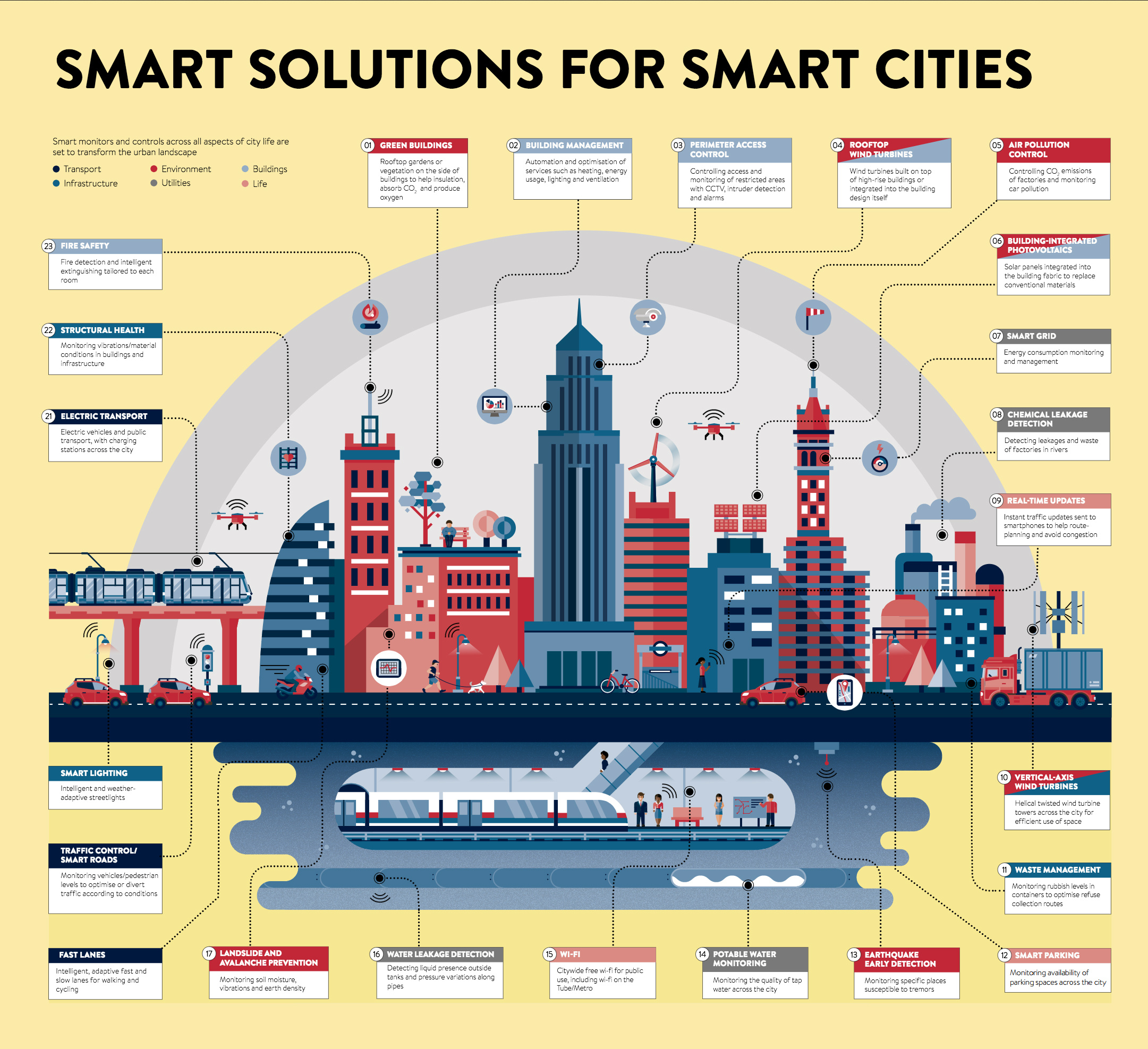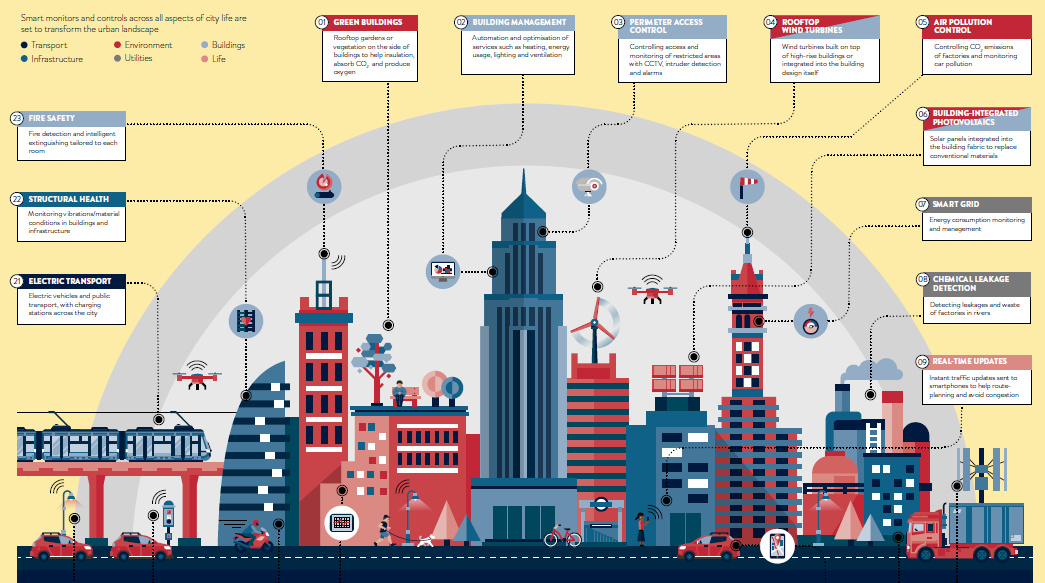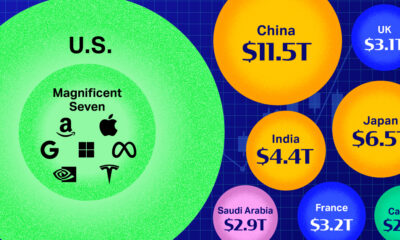Technology
Infographic: The Anatomy of a Smart City

The Anatomy of a Smart City
There is no doubt that the city will be the defining feature of human geography for the 21st century.
Globally, there are 1.3 million people moving to cities each week – and by 2040, a staggering 65% of the world’s population will live in cities.
At the same time, the 600 biggest urban areas already account for 60% of global GDP, and this will only rise higher as cities become larger and more prosperous. In fact, experts estimate that up to 80% of future economic growth in developing regions will occur in cities alone.
The Smart City: A Necessary Step
As cities become an even more important driver of the global economy and wealth, it’s becoming crucial to ensure that they are optimized to maximize efficiency and sustainability, while enhancing the quality of life in each urban conglomeration.
Today’s infographic from Postscapes helps define the need for smart cities, and it also gives great examples of how technology can be applied in urban settings to facilitate cities that work better for their citizens.
Features of Tomorrow’s Cities
Smart cities will use low power sensors, wireless networks, and mobile-based applications to measure and optimize everything within cities.
Here are just some examples: (click below image to open full-size version)
Smart city solutions will fall into six broad categories, transforming the urban landscape:
1. Infrastructure
Smart lighting is one of the most important solutions that will be implemented in citywide infrastructure. While smart lighting sounds trivial at first glance, it’s worth noting that lighting alone consumes a whopping 19% of the world’s total electricity.
2. Buildings
Heating, energy usage, lighting, and ventilation will be managed and optimized by technology. Solar panels will be integrated into building design, replacing traditional materials. Fire detection and extinguishing is tailored to individual rooms.
3. Utilities
Smart grids (used for energy consumption monitoring and management), water leakage detection, and water potability monitoring are just some smart city aspects on the utilities side.
4. Transport
Intelligent, adaptive fast lanes and slow lanes (cycling, walking) will be implemented, while charging stations through the city will power EVs.
5. Environment
Air pollution control, renewable energy, and waste management solutions will make for greener cities. Rooftop gardens or side vegetation will be integrated into building designs, to help with insulation, provide oxygen, and absorb CO2.
6. Life
There will be citywide Wi-Fi for public use, while real-time updates will provide citizens information on traffic congestion, parking spaces, and other city amenities.
The Effect?
Cisco estimates that smarter cities will have impressive increases in efficiency: using many of the above concepts, cities can improve energy efficiency by 30% in 20 years.
Simultaneously, it’s estimated that the broad market for smart cities products and services will be worth $2.57 trillion by 2025, growing at a clip of 18.4% per year on average.
Brands
How Tech Logos Have Evolved Over Time
From complete overhauls to more subtle tweaks, these tech logos have had quite a journey. Featuring: Google, Apple, and more.

How Tech Logos Have Evolved Over Time
This was originally posted on our Voronoi app. Download the app for free on iOS or Android and discover incredible data-driven charts from a variety of trusted sources.
One would be hard-pressed to find a company that has never changed its logo. Granted, some brands—like Rolex, IBM, and Coca-Cola—tend to just have more minimalistic updates. But other companies undergo an entire identity change, thus necessitating a full overhaul.
In this graphic, we visualized the evolution of prominent tech companies’ logos over time. All of these brands ranked highly in a Q1 2024 YouGov study of America’s most famous tech brands. The logo changes are sourced from 1000logos.net.
How Many Times Has Google Changed Its Logo?
Google and Facebook share a 98% fame rating according to YouGov. But while Facebook’s rise was captured in The Social Network (2010), Google’s history tends to be a little less lionized in popular culture.
For example, Google was initially called “Backrub” because it analyzed “back links” to understand how important a website was. Since its founding, Google has undergone eight logo changes, finally settling on its current one in 2015.
| Company | Number of Logo Changes |
|---|---|
| 8 | |
| HP | 8 |
| Amazon | 6 |
| Microsoft | 6 |
| Samsung | 6 |
| Apple | 5* |
Note: *Includes color changes. Source: 1000Logos.net
Another fun origin story is Microsoft, which started off as Traf-O-Data, a traffic counter reading company that generated reports for traffic engineers. By 1975, the company was renamed. But it wasn’t until 2012 that Microsoft put the iconic Windows logo—still the most popular desktop operating system—alongside its name.
And then there’s Samsung, which started as a grocery trading store in 1938. Its pivot to electronics started in the 1970s with black and white television sets. For 55 years, the company kept some form of stars from its first logo, until 1993, when the iconic encircled blue Samsung logo debuted.
Finally, Apple’s first logo in 1976 featured Isaac Newton reading under a tree—moments before an apple fell on his head. Two years later, the iconic bitten apple logo would be designed at Steve Jobs’ behest, and it would take another two decades for it to go monochrome.
-

 Green1 week ago
Green1 week agoRanked: The Countries With the Most Air Pollution in 2023
-

 Automotive2 weeks ago
Automotive2 weeks agoAlmost Every EV Stock is Down After Q1 2024
-

 AI2 weeks ago
AI2 weeks agoThe Stock Performance of U.S. Chipmakers So Far in 2024
-

 Markets2 weeks ago
Markets2 weeks agoCharted: Big Four Market Share by S&P 500 Audits
-

 Real Estate2 weeks ago
Real Estate2 weeks agoRanked: The Most Valuable Housing Markets in America
-

 Money2 weeks ago
Money2 weeks agoWhich States Have the Highest Minimum Wage in America?
-

 AI2 weeks ago
AI2 weeks agoRanked: Semiconductor Companies by Industry Revenue Share
-

 Travel2 weeks ago
Travel2 weeks agoRanked: The World’s Top Flight Routes, by Revenue
















